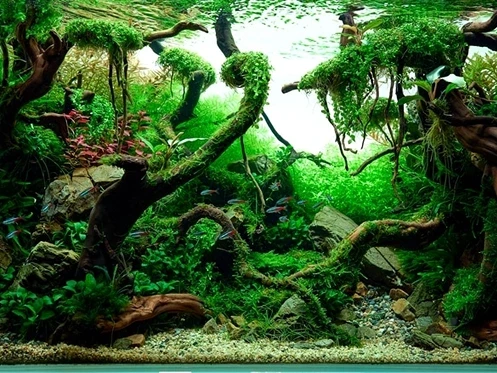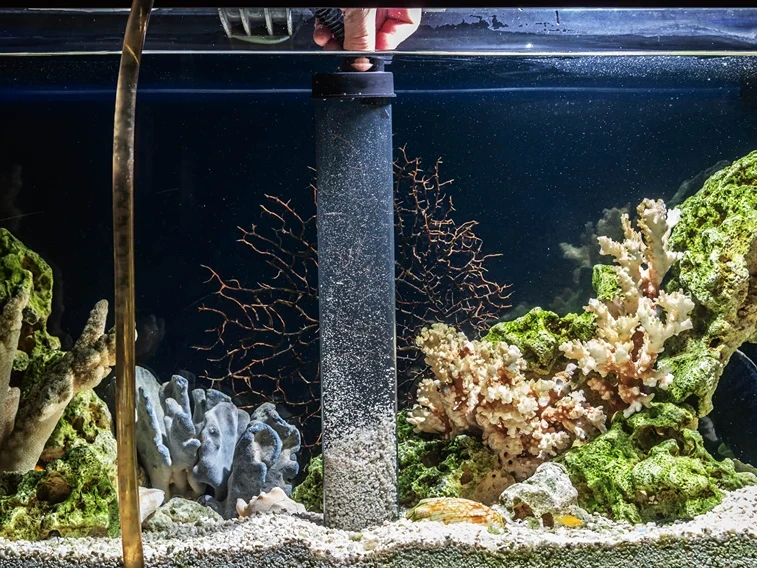Aquarium care is a year-round commitment that requires adjustments and attentiveness to the changing seasons, especially in the United Kingdom where the weather can vary significantly. As the seasons shift, so do the needs of your aquatic environment, from temperature fluctuations to dietary changes. This guide aims to navigate you through the essentials of seasonal aquarium care, ensuring your aquatic life thrives throughout the year.
Jump to:
Key Takeaways
- Spring Care: Focus on temperature adjustments, plant care, and dietary changes to support growth.
- Summer Care: Implement cooling techniques, control algae growth, and adjust feeding practices.
- Fall Care: Prepare for cooler temperatures with gradual adjustments and prepare fish for lower metabolism rates.
- Winter Care: Ensure your aquarium is warm, adjust diets for colder months, and prevent diseases.
Aquarium enthusiasts know that each season brings its own set of challenges and opportunities for creating a thriving aquatic ecosystem. Let’s dive into the seasonal care strategies that will keep your aquarium at its best, no matter the weather outside.
Register for our latest in-depth reviews and product round-ups from the experts
Enter your email address below to receive our twice monthly reviews emails.
By entering your details, you are agreeing to our terms and conditions and privacy policy. You can unsubscribe at any time.
Spring Care: Awakening of Life

Adjusting to Spring: Preparing Your Aquarium for Growth
Spring in the UK signals a time of awakening and growth, not just for terrestrial plants but for aquatic life as well. As the days get longer and temperatures begin to rise, it’s crucial to adjust your aquarium to match the changing environment.
- Temperature Adjustments: Gradually increase the water temperature to mimic the natural warming of water bodies. This encourages fish to come out of their winter dormancy and resume active feeding and breeding behaviors.
- Plant Care and Introduction: Spring is the perfect time to introduce new plants or trim back overgrowth. Increased sunlight can promote algae growth, so introducing fast-growing plants can help outcompete algae for nutrients.
- Diet Changes for Aquatic Life: As fish become more active, their dietary needs increase. Transition to a high-protein diet to support growth and vitality.
Table 1: Spring Aquarium Checklist
| Task | Description |
| Temperature Adjustment | Gradually increase to 2-3°C higher than winter levels. |
| Plant Care | Trim dead leaves, introduce new plants. |
| Feeding | Shift to high-protein foods to support increased activity. |
Summer Care: Maintaining Stability
Summer Maintenance: Keeping Your Aquarium Cool and Stable
The UK summer can bring about a significant rise in temperatures, which can be challenging for aquariums. High temperatures can lead to oxygen depletion and promote excessive algae growth.
- Cooling Techniques for Aquariums: Use fans to evaporate water from the surface or consider a chiller for larger tanks. Keep the aquarium away from direct sunlight and use LED lights that emit less heat.
- Algae Control and Prevention: Increase water changes and manually remove algae. Consider adding algae-eating fish or snails to your tank.
- Summer Feeding Practices: Fish may have increased appetites, but overfeeding can lead to water quality issues. Feed small amounts frequently, and ensure all food is consumed within a few minutes.
Table 2: Summer Aquarium Maintenance
| Task | Description |
| Cooling | Use fans or a chiller to maintain optimal temperature. |
| Algae Control | Increase water changes, add algae eaters. |
| Feeding | Adjust feeding frequency and quantity to prevent overfeeding. |
Fall Care: Preparing for Dormancy

Transitioning into Fall: Adjustments for Cooling Temperatures
As the UK moves into autumn, temperatures start to drop, signaling a time for aquarists to prepare their tanks for the coming cold.
- Gradual Temperature Adjustments: Begin to lower the water temperature gradually to prepare your aquatic life for cooler months. This mimics the natural progression into winter, reducing stress on your fish.
- Preparing Fish for Lower Metabolism Rates: As temperatures drop, fish metabolism slows down. Reduce feeding frequency and switch to foods that are easier to digest.
- Plant Care as Light Changes: With shorter days, adjust your lighting schedule to ensure your plants continue to receive enough light. Consider using a timer to mimic natural daylight hours.
Winter Care: Ensuring Comfort and Health
Winter Strategies: Keeping Your Aquarium Warm and Healthy
Winter in the UK can be harsh, with cold temperatures posing a threat to the delicate balance within your aquarium.
- Heating Solutions: Ensure your heater is functioning correctly and set it to maintain a stable temperature suitable for your specific fish species. Regularly check the temperature to prevent fluctuations.
- Diet Adjustments for Colder Months: Fish are less active in winter and require less food. Feed a lower-protein diet and consider foods that are high in fiber to aid digestion.
- Disease Prevention in Winter: Cold stress can make fish more susceptible to diseases. Maintain water quality with regular changes and monitor fish for signs of stress or illness.
Advanced Lighting and Temperature Control
Using Timers and Thermostats for Optimal Conditions
To mimic the natural environment as closely as possible, employing timers for your lighting and thermostats for heating can play a crucial role. These devices ensure consistency, which is vital for the well-being of both fish and plants.
- Timers: Set your lights to turn on and off at the same times each day to simulate natural daylight cycles. This is especially important during the shorter days of winter and longer days of summer.
- Thermostats: A reliable thermostat will keep your aquarium’s temperature stable throughout the day and night, adjusting the heater’s output as needed to counteract any room temperature fluctuations.
Maintaining Water Quality Through the Seasons

Seasonal Water Changes and Testing
Regular water changes and testing are paramount to maintaining high water quality. However, the frequency and volume may vary with the seasons due to changes in temperature, light, and fish activity levels.
- Water Changes: In summer, increased temperatures can lead to faster waste accumulation, possibly requiring more frequent water changes. In contrast, winter might see a reduction in change frequency due to lower fish metabolism and feeding rates.
- Testing: Regular testing for ammonia, nitrites, nitrates, pH, and hardness helps identify any seasonal shifts in water chemistry, allowing for timely adjustments.
Table 3: Seasonal Water Change Guidelines
| Season | Water Change Frequency | Notes |
| Spring | Every 2 weeks | Support growing plants and active fish. |
| Summer | Weekly | Counteract higher waste levels and temperatures. |
| Fall | Every 2-3 weeks | Prepare for reduced winter activity. |
| Winter | Monthly | Adjust for slower metabolism and reduced feeding. |
Adapting Feeding Practices for Seasonal Needs
Understanding and adapting to the dietary needs of your aquatic life throughout the seasons are crucial for their health and the overall balance of your aquarium.
- Spring and Summer: Increase feeding frequency to support growth and higher activity. However, be mindful of water quality and avoid overfeeding.
- Fall and Winter: Reduce feeding frequency and volume as fish activity and metabolism decrease. Opt for foods that are high in fiber to aid digestion during these colder months.

Frequently Asked Questions About Seasonal Aquarium Care
Adjust your aquarium’s temperature gradually over several days to avoid shocking your fish. Increase temperatures in spring and reduce them in fall, using a reliable aquarium heater and thermostat to maintain stable conditions.
- Spring/Summer: Feed 2-3 times a day, with food consumed within a few minutes.
- Fall/Winter: Reduce feeding to once a day or every other day, focusing on easily digestible foods.
- Increase water changes and manually remove visible algae.
- Use a UV sterilizer to control algae spores in the water.
- Introduce algae-eating fish or invertebrates to your aquarium.
Table 4: Algae Prevention Tips
| Strategy | Description |
| Water Changes | Increase frequency to reduce nutrients. |
| UV Sterilizer | Install to kill algae spores in the water. |
| Algae Eaters | Add species like plecos or shrimp to your tank. |
By implementing these advanced care techniques and addressing common questions, you can ensure your aquarium remains a vibrant and healthy environment throughout the changing seasons. Remember, the key to successful aquarium care is observation, adaptation, and a proactive approach to meeting the needs of your aquatic inhabitants.
Martin Cochran
Dive into fish care with Martin, your guide from the coastal beauty of Brighton. He shares tips on keeping your aquatic companions happy and healthy. Join him on a fin-tastic journey where every swim is a voyage of joy. Trust Martin for a smooth sailing aquatic experience.




